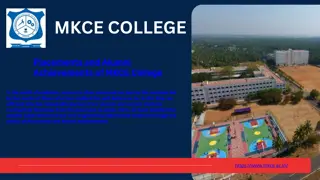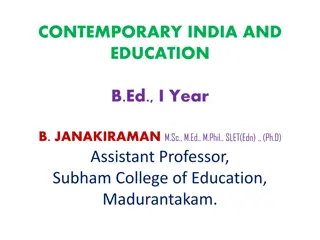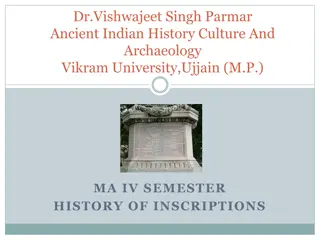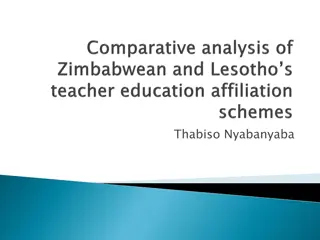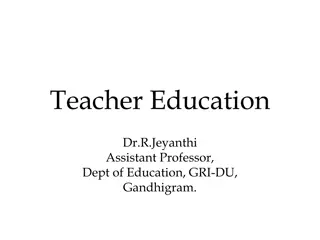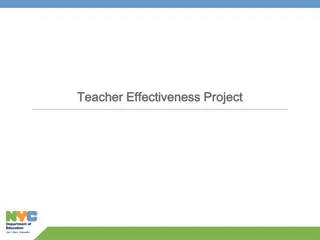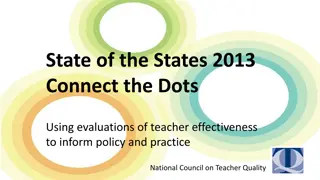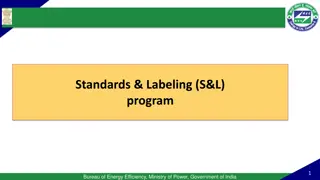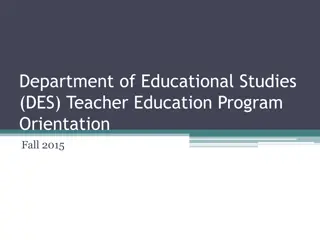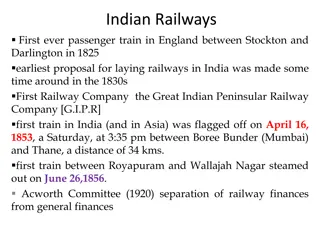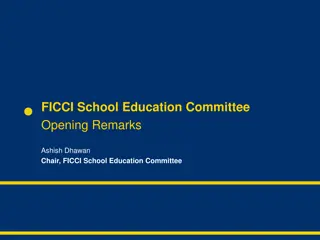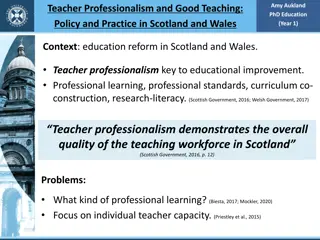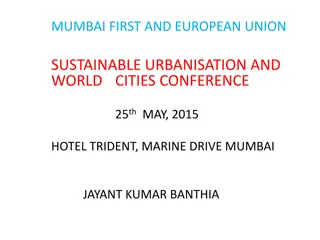Evolution of Teacher Education in India: Achievements and Challenges
Teacher education in India has evolved over the centuries, from the era of grateful, benevolent teachers in ancient times to the modern-day focus on practical and quality-driven training. The pre-independence period saw a contrast between European scientific advancements and religious education in India. Post-independence, the focus shifted to mainstreaming Teacher Education Institutions and enhancing quality, reflecting a continuous journey of development and challenges in the field.
Download Presentation

Please find below an Image/Link to download the presentation.
The content on the website is provided AS IS for your information and personal use only. It may not be sold, licensed, or shared on other websites without obtaining consent from the author. Download presentation by click this link. If you encounter any issues during the download, it is possible that the publisher has removed the file from their server.
E N D
Presentation Transcript
POLICY PERSPECTIVE IN TEACHER EDUCATION: ACHIEVEMENTS AND CHALLENGES Ms. Anamika Singh Ministry of Human Resource Development Govt. of India
TEACHERS IN ANCIENT INDIA Grateful, benevolent, intelligent, pious, free of mental and physical pains, apathetic to fault- finding, virtuous, capable of serving others, amiable, educated and the giver of wealth- such men are fit to teach. -Y gyawalkyasmriti - ch r dhy yah ||2
PRE INDEPENDENCE PERIOD After Renaissance, Europe witnessed a sudden burst in scientific and technological advancement. Natural Philosophy, Chemistry, Anatomy, Geography, History, Science, Literature and other such subjects of education emerged. Whereas education in India was still largely religious.
CONTD Modern and progressive thinkers were keen to bring English Education in India as well as the idea of a secular, objective, scientific and systematic form of education appealed to them. Institution for training teachers was first started by Danish Missionaries in India. A normal training school was established by at Serampur (West Bengal) in 1802.
CONTD Need for systematic training for teachers began to be realized by educational societies in the third decade of the 19th century in the presidencies of Calcutta, Madras and Bombay. The Wood's Despatch of 1854, the Education Commission of 1882, laid further emphasis on good quality Teacher Training.
GANDHI ON TEACHER TRAINING AND EDUCATION In 1937, M.K. Gandhi convened Wardha Educational Conference Propounded a new system of education popularly known as 'Basic Education'. Gandhiji felt the need of making teacher- training more practical and functional. He offered craft-centred education for child, correlated with life situations. With this, the emphasis in teacher-training now shifted to the type of education which was practical and based on the needs of the pupils and the community.
POST INDEPENDENCE (1947) DEVELOPMENTS IN TEACHER EDUCATION By 1947, Teacher Education was a comprehensively established field in India Institution building took place during the decades of 50 s and 60s However, with time, the isolation of Teacher Education Institutions became pronounced Kothari Commission set up by Government of India in the 1960s to examine this sector mentioned the need to bring Teacher Education in the mainstream and to focus on quality
NATIONAL POLICY ON EDUCATION The status of the Teacher reflects the socio cultural ethos of a society, it is said that no people can rise above the level of its teachers. National Policy on Education, 1986
NPE, 1986 Teacher Education is a continuous process, both pre service and in service components are important Establishment of District Institutes of Education and Training (DIETS) Teachers should have the freedom to innovate, to devise appropriate methods and activities relevant to the needs and concerns of the community
CRUCIAL DEVELOPMENTS IN TE IN INDIA IN RECENT YEARS The Nation Council of Teacher Education, a body with a clear objective to achieve planned and coordinated development of the teacher education system throughout the country and to ensure the regulation and proper maintenance of Norms and Standards in the teacher education system,given a statutory status in 1995; Nation Curriculum Framework(NCF),2005;
CONTD Nation Curriculum Framework for Teacher Education, 2009; Right of Children to free and Compulsory Act, 2009; The Restructured Scheme of Teacher Education launched in 2012; The Justice Verma Commission Report on Teacher Education, 2012;
NCFTE, 2009 Articulates a vision for TE in India. Reflective Practice to be central aim of TE; Student Teachers should have opportunities for self learning, reflection, assimilation and articulation of new ideas; Developing capacities, ability to think, be critical and work in groups; Providing opportunities for student teachers to observe and engage with children;
RIGHT TO EDUCATION ACT, 2009 Central Govt. to enforce standards for training of teachers; All untrained teachers in the school system to be trained within a period of 5 years; Central Govt. to appoint a body to lay down the minimum qualifications for becoming a teacher;
CURRICULUM NCF; SEC 29(2) RTE; AND NCFTE Constitutional values All round development of the child Learning through activities In mother tongue CCE understanding of child s knowledge and ability to apply the same Co-constructors of knowledge Create opportunities for children to discover; connect knowledge to life outside school.
CENTRALLY SPONSORED SCHEME OF TEACHER EDUCATION Centrally Sponsored Scheme on Teacher Education initiated in 1987 Scheme was last revised in 2002 for the X Plan Main Components: Setting up of DIETs Up-gradation of secondary teachers institutions into CTEs and IASEs Strengthening of SCERTs 100% Central assistance for recurring and non-recurring provided States/UTs for DIETs, CTEs, IASEs and SCERTs Report of NCERT ofAugust, 2009 on evaluation of the Scheme With background support of the earlier studies and various reports and inputs from various stakeholders, work started on remodeling and revising the existing scheme of Teacher Education Revised Scheme launched in 1stApril, 2012
MAIN FEATURES OF CSSTE Budget Outlay of Rs. 6000 crores in the 12thPlan period (2012-17); Focus on strengthening of Institutions and creating new ones in remote areas of the country; Central Government fund share of 75% being provided to States for improving the Teacher Education Institutes be it Infrastructure Development, Faculty Development, Creation of Labs and Special Cells, Use of ICT and so on; Release of grant linked with conditions like filling up vacant positions in Teacher Education Institutes and so on;
CONTD States advised to form State Monitoring Committee for CSSTE for better monitoring and evaluation; TE course Curriculum revision process underway in line with the provisions of NCFTE; Training to In-Service teachers being provided through ODL mode run by Universities; Thrust is on collaborative processes- to harness the knowledge of experts in the field rather than doing anything in isolation;
WHAT HAS BEEN THE SHIFT? Knowledge as given to knowledge as created Form rote learning to understanding From just provind education to providing quality education Teacher as repository of all knowledge to a co- constructor of knowledge; Teacher at the centre of knowledge creation; Education to be context-specific not alienating Address issues like gender, access, diversity of classroom through new ways of teaching practices;
CHALLENGES REMAIN Inadequate institutional capacity for professional preparation of teachers; Ensuring quality training esp. in ODL courses; Creation of a strong cadre of teacher educators with strong recruitment policies and good working conditions to raise the overall status of a teacher educator and to ensure talented people join this profession;
CONTD Redesign teacher education to professionally equip teachers to teach in diverse classrooms; Widen and deepen state presence in the sector of teacher education; Reconceptualise teacher education to enable a convergence between school curriculum and the education of teachers;
CONTD Ensure training helps teachers cope with issues of diversity, inclusion, regional variations and so on; Creation of enabling environment for good private person(s) to set up Teacher Education Institutes of quality and excellence; Bring Special Education, Vocational Education into Teacher Education;
WAY FORWARD Many of these issues have come as Recommendations of the Justice Verma Commission Report that came out in 2012; It has given overarching recommendations addressing issues like INSET, PSET, Overhauling Regulatory Structures that govern Teacher Education Institutes, bringing Teacher Education in the fold of Higher Education and so on; MHRD, along with other stakeholder agencies like University Grants Commission (UGC), National Council for Teacher Education (NCTE)and State Governments is committed to working on these recommendations to bring about a change in this sector;







